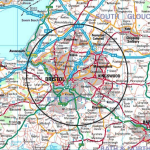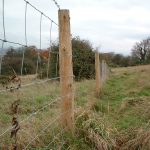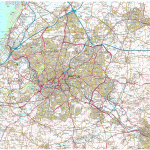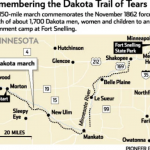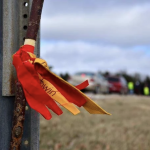A collection of soundwalks made with Filipina domestic and care workers employed “behind closed doors” in the Lebanon and the UK. Check out the soundwalks.
Category Archives: Power Dynamics
Heath Bunting and Kayle Brandon, BorderXing (2002)
“BorderXing, a 2002 commission for the Tate Gallery in London, in which Mr. Bunting, 37, and Ms. Brandon, 28, documented illegal treks they made across European borders.
“I’ve always wanted to be nomadic — to beg, borrow, find things,” Mr. Bunting said. He travels light, often with no change of clothes and only a few basics: a penknife, a diary, a passport.
The BorderXing Web site, available for individual use by request (at irational.org/cgi-bin/border/clients/ deny.pl) offers pictures, suggested routes and tips for evading the authorities. A vacation slide show of the couple’s journey is on view at the New Museum, as well as online, without registration, at duo.irational.org/borderxing–slide–show.
Despite the political provocation involved, the project retains the aura of a pilgrimage — to be close to the land, to throw off the weight of nationality and statehood, simply to put one foot in front of the other and go.
… BorderXing is concerned with the physical, visceral aspects of travel…” [credit] [full article as PDF]
Heath Bunting and Kayle Brandon, D’Fence Cuts (2001)
“Heath Bunting emerged from the 1980s art scene committed to building open, democratic communications systems and social contexts. Throughout his career, he has explored multiple media including graffiti and performance art and has staged numerous interventionist projects, as well as being a pioneer in the field of Internet Art. Bunting began collaborating with artist Kyle Brandon in 2001.” [credit]
These artists devised a circular tour (see map), and by night stealthily cut some fences as part of their Borderxing project. BorderXing serves as a pratical guide to crossing major international borders, legally or illegally. It was a type of physical hacking of space, cutting anything that impeded their walk – D’Fence Cuts. Below is an excerpt from their tour de fence catalog:
“tour de fence is the answer to your real needs. while the internet promised to level out all barriers, tour de fence enables you to surmount the fences out there that people erect to obstruct your way every day. from wire netting to ru stic fence, from steel door to close security system, tour de fence offers you the necessary know-how for unhampered movement. tour de fence is the direct way.
learn offroad mobility within high security architecture. cross over stretches of land in the right direction. penetrate the underground area of your city. tour de fence puts an end to the relocation of your movements into virtual space. use the tour de fence! become a tour de fence amateur team. pass this handbook on to others. propagate tour de fence.
by doing so you will become part of the international tour de fence community. as a reader, a free-climber or by sending one of the 24 tour de fence postcard in this book.
participate now! tour de fence’s vision is to do what we want.
…
tour de fence acknowledges fence as metaphor for private property. fence as a supposedly temporary, often mobile barrier performing functions of inclusion and exclusion, entrapment and guided freedom, decoration, safety, user boun dary, protection from hazard, flow control, visual screening and user separation.
fence is a permeable filter system defining permitted use and users. light, wind, insects, water, plants and sound pass unhindered while high order life forms such as·humans, fish, cattle and cars are engaged:
development of fence.
up to now the vertical has generally been private while the horizontal public. increasingly, vertical fences are being rotated to the horizontal and enlarged over large areas of land, as all use and users are embraced in total control.
tour de fence recognises the transformation of framed freedom into restricted open-range roaming; the re-alignment of unknown possibilities into known re peatables. users are permitted to skate across flattened surface of fence, but not to pass through – the fence is everywhere.” (credit)
Michèle Magema, Element (2005)
ELEMENT from Michèle Magema on Vimeo.
“The artistic work of Michèle Magema is erected in an intermediate zone, a mental space, a produced border, an interstice located between the double Western and African projections.
The plurality of his affiliations allows him to question his history and that of a nation, a continent and more broadly of the World. The relationship she maintains with stories and History allows her to invent a critical posture.
Michèle stages herself, and reveals both her questioning and her discernment through her photos and video installations imbued with an intimate femininity, while addressing fundamental points in the history of humanity.
In Element, the artist tries to put into images universal exotic projections that are implied. A humming voice, sensual feet, shod in white accompanies a hand that picks cotton on the asphalt. A head, fragment, advances in profile, balancing a basin. The same chained ankle feet move slowly, in high heels. The three images coexist, carried by a long tracking shot that allows us to follow this woman, like the watermark of an evocation of the female condition in general.
Again, Michèle Magema tells and retells History in images. Drawing from the archives, restoring a balance in a rickety reality, she pursues her singular quest linked to her own cultural diversity as well as to her feminine gender.” [credit]
Dakota Commemorative Walk (2002-2012)
“They walked past red barns and white picket fences, past new housing developments and plowed fields dusted with snow. They walked with blisters on their feet and with hats pulled low to ward off the winter wind. They walked to remember.
The sixth annual Dakota Commemorative Walk ends Tuesday, Nov. 13, 2012 after six days retracing the footsteps of the 1,700 Dakota women and children who were forced to march 150 miles to Fort Snelling after the U.S. Dakota War of 1862.
Some call it Minnesota’s Trail of Tears.
“This is a ceremony,” said Gwen Westerman, who teaches humanities at Minnesota State Mankato and who has walked with the group since 2004. “It’s not a protest. It’s not a re-enactment. It’s a spiritual ceremony for healing and for honoring those women and children we descend from. We remember their strength and their determination.”
The first commemorative walk was organized in 2002, and organizers have held one every two years, leading up to this year, the 150th anniversary of the original march. After the Dakota War of 1862, the Dakota men who attacked government offices and white settlements were given cursory trials. Just more than 303 were condemned, and 38 were hanged in Mankato, remembered as a notorious event in Minnesota history.
After the war, 1,700 men, women, children, elders and mixed-race noncombatants were marched to a fenced camp along the river beneath Fort Snelling. During the winter of 1862-63 hundreds died of illness and exposure. In the spring, the remaining 1,300 were taken by steamboat and trains to a semiarid reservation at Crow Creek, S.D., where many more died of starvation and illness.
“They lived through three horrific experiences,” said Chris Mato Nunpa, a retired professor at Southwest Minnesota State University, who was bundled in a black coat and who talked as he walked along the shoulder of the road.
“They lived through this forced march, through the concentration camp, and through the forcible removal from Minnesota.”
He called their ordeal a genocide.
This year’s walkers set out just after dawn Wednesday from the parking lot of the Lower Sioux Agency in Morton, in the Minnesota River Valley. By Monday afternoon, the group had passed through the town of Jordan after covering about 20 miles a day. They walked on the shoulder of Scott County Hwy. 17, followed by a caravan of cars and vans carrying friends, supporters and elders too frail to make the journey on foot. Some people walk all six days; others join for a few days or even a few hours.
Each day, the procession is led by a woman carrying a sacred pipe wrapped in a blanket, surrounded by a quiet group. Farther back, people chat. The walkers stop and place a marker about every mile and honor two ancestors from the march.
At one stop Monday, a woman cleared weeds growing at the base of a tall electrical pole. She pounded a stake into the ground, topped with red and yellow ribbons. Someone called the names on the ribbon into the chilly wind: “Alek Graham. Maline Mumford.”
Then one by one, people went forward, took a pinch of tobacco from a leather pouch and sprinkled it over the stake.
“The name is not just a name. When we call their name, they come,” explained Nick Anderson, cultural chairperson for the Mendota Mdewakanton Dakota Community. “They are here with us.”
He said he walked as a way to thank his ancestors, one of whom was a sister of Chief Little Crow.
“When I think of what they had to endure, I don’t know if we can ever give enough thanks,” he said. “We survived, but we have lost a lot of our culture. Participating in this is a way for me to get some of that back.”
Other people came long distances to walk.
“The reason I’m here is because my great grandmother was on this march with her four kids and her mother,” said Reuben Kitto, who flew in for the march from Florida, where he spent 30 years working for Honeywell. Kitto spent his childhood on the Santee Sioux Reservation in Nebraska where many Minnesota Dakota were sent.
“This walk brings us back to the reality of how hard it was for them,” Kitto said. “The weather was a lot like this, there was a little bit of snow.”
“It’s a way for me to spend a day with my grandmother,” he said.
It’s also a way for him to spend time with his living family. His nephew Robert Thomas drove up from Winona to join the march for a day. Thomas is working on a commissioned play about the Dakota war and exile for the Minnesota History Theater and is concerned with helping both Dakota and non-Dakota remember the Dakota’s past.
“The old aunties and uncles are still passing down the stories,” he said. “The struggle is to get the younger generation interested.”
Kitto’s daughter, Ramona Kitto Stately of Shakopee, also was on the march, bundled in a long red coat and walking next to her father. Stately coordinates Indian education for the Osseo Area Schools and this year, as in past years, brought several students along on the walk.
As the sun started to dip low, she and others arrived at the Shakopee Mdewakanton Sioux Community center, where they would eat dinner together and reflect on that day’s walk.
“We carry a deep grief inside and if we don’t connect with that grief, we can’t heal,” Stately said.” [credit]
Michèle Magema, Oyé Oyé (2002)
Oyé Oyé / screen 2 from Michèle Magema on Vimeo.
Oye Oye, 2002
Video, 5:30 min.
Michèle Magema
* 1977 Kinshasa, Democratic Republic of Congo
“In Oyé Oyé Michèle Magema deals with the Memory of the father and an entire generation of men and women who were eager to achieve a modern Africa. Oyé Oyé is about nation-building, a stop on the journey to a so-called « utopialand ». It is the raving story of a man who seized power and perverted history, Mobutu Sese Seko, who ruled Zaire (now Democratic Republic of Congo) from 1965 to 1997. Mobutu pursued a phantasmagorical vision of an « authentic » Africa. (« Autenticity » was political, social, economic, and cultural ideology implemented in 1970 with the goal of shaking off all colonial influence, to the point of banning Western poducts and prohibiting Christian names.)
Magema’s Oyé Oyé is a two-channel video installation; on one side the artist, shown without a head, mimes a military march; on the other are public images from the Mobutu era, such as parades. In both the African female body is shown as an instrument of propaganda. By parodying the political concept of identity, Magema forces us to reconsider a country’s past.
May Murad and Rachel Ashton, Walking Without Walls (2017-18)
“Digital Dialogue on Peace, Friendship and Boundaries
Painters May Murad (Gaza) and Rachel Ashton (Huntly) digitally collaborated throughout 2017 to plan two 2018 Slow Marathons in the places they come from.
2018 is the centenary year of the end of WW1. It is also the year when Britain occupied the Palestinian territory of Gaza, – its turbulent history has since been shaped by this event. The Gaza strip is of exact marathon length (26 miles/42k) with walls at each end. We can not visit, and they can not come out. How can we extend and keep up friendships when we can never visit each other? Can socially engage if we never physically meet the other?
The digitally driven exchange project Walking without Walls partnership explored how we can collaborate artistically and socially despite restrictive political situations. The two artists shared through image and video, skype and whatsapp, sketches and text their respective landscapes in their very different geo-political settings. While Rachel negotiated her way with landowners and farmers, May dealt with the complexities of living in an occupied territory. Drawing on the plant journals of WW1 pacifist Rosa Luxemburg – created whilst imprisoned – the artists recorded and shared plants with curing powers in their different climates, while looking for new paths, friendship and ways of healing along the way.
Walking Without Walls formed two marathon length walks. One in Gaza and the other along the river Isla from Dufftown via Keith to Huntly. It featured exhibitions in both places, a catalogue of healing plants and a Pathmakers’ Gathering on political walking. See photos from the day here.
The artists’ path-making explorations into their own land were accompanied by a year-long exchange through various digital applications. In a time of rising nationalism and restrictive legislations that hinder crossings of national borders, the two artists have been exploring opportunities and limits of new technologies in fostering transnational long-distance collaboration. Paintings, drawings and other documentation resulting from their visual exchange was displayed at Tate Exchange on 25th May. ” [credit]
Stuart McAdam, Lines Lost (2013-14)
“A project tracing the routes of branch lines that were cut following the Beeching Report in 1963
Stuart McAdam came to Huntly in Summer 2013 from Glasgow.
Stuart’s Lines Lost project was triggered by the infamous railway cuts which saw train tracks closed as a result of Dr Richard Beeching’s recommendations 50 years ago. Through a series of performative walks with all kinds of people along the former Portsoy to Huntly route, McAdam’s aim was to bring into focus the historic and contemporary concerns surrounding our transport legacy.
Through walking the former track again and again, people have seen him reawaken the route that has been subsumed into the landscape – like remains of ghostly traces of the line that once linked communities. Linking natural with industrial and social history of the past 50 years he interrogated the historical, cultural and contemporary resonances through a series of documented walks.
The North of Scotland was one of the areas most affected by the Beeching cuts with local stopping train routes such as Aberdeen – Inverurie, Aberdeen – Keith – Elgin, Huntly to Banff and Portsoy, Banff – Tillynaught, Fraserburgh – St Combs, Elgin – Lossiemouth, Aberdeen – Ballater and Fraserburgh, Maud – Peterhead and Aviemore – Elgin via Inverness, cut. Many of those that crossed the county have never been replaced by other forms of public transport making journeys difficult and adding hours to travel time for those not having access to private cars – passengers have to travel south to Aberdeen or north to Elgin to get connections often having long waits between buses. McAdam repeatedly walked the route from Huntly to Portsoy, experiencing it through different eyes every time.
“Physical and transparent remnants of most of the lines still exist within the landscape and I hope to reawaken them in the public consciousness”, said McAdam, who has explored journeys, boundaries and slow travel in a range of artworks.
“As we mark the 50th anniversary of the publication of the Beeching report is also fitting time to consider the impact that the cuts had on the relative development and decline of the many towns and villages that lay along the historic routes, routes that were often life lines for outlying communities.”
McAdam was at the Edinburgh Art Festival the 1st of August. For more information go to the event page.
Stuart also participated in the Room to Roam Festival” [credit]
Yasmeen Sabri, Walk a Mile in her Veil (2016)
“Walk a Mile in her Veil is an introspection of Arab identity through the lens of the veil and its user, inviting visitors to try on the veil and understand first-hand the cultural, social, and feminist motives behind it.” [credit]
Kinder Mass Trespass (1932)
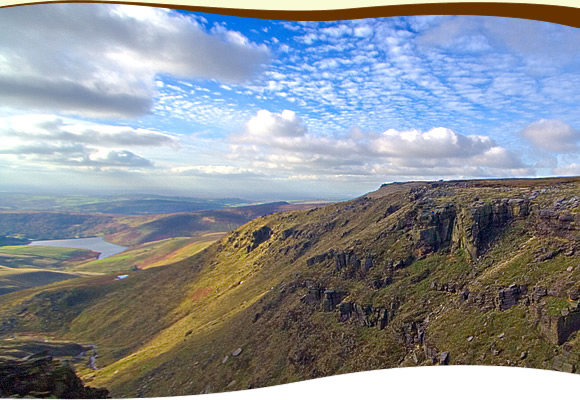
Kinder Reservoir from Kinder Scout [credit]
The event was organised by the Manchester branch of the British Workers Sports Federation. They chose to notify the local press in advance, and as a result, Derbyshire Constabulary turned out in force. A smaller group of ramblers from Sheffield set off from Edale and met up with the main party on the Kinder edge path.
Five men from Manchester, including the leader, Benny Rothman, were subsequently jailed.
75 years later the trespass was described as:
the most successful direct action in British history
Lord Roy Hattersley, 2007.“
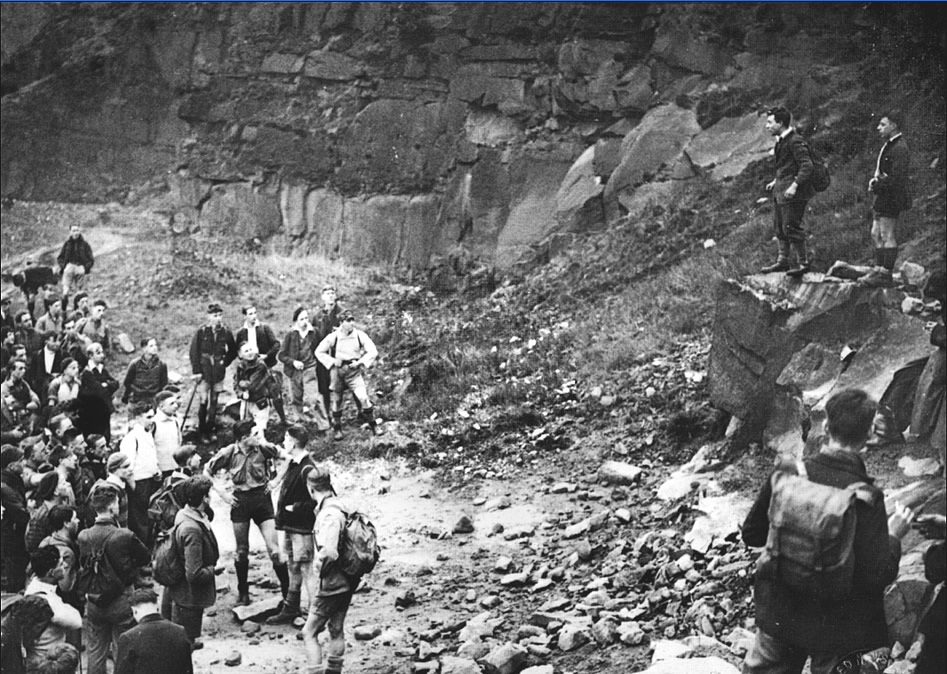
Bowden Bridge Quarry 1932
“The trespass is widely credited with leading to:
- legislation in 1949 to establish the National Parks
- contributing to the development of the Pennine Way and many other long distance footpath
- securing walkers’ rights over open country and common land in the C.R.O.W. Act of 2000
The trespass was controversial at the time, being seen as a working class struggle for the right to roam versus the rights of the wealthy to have exclusive use of moorlands for grouse shooting. It remains controversial today, both for those reasons and because some think its importance has been overstated. Our aim is to tell the story of the mass trespass, but to put it in the context of all the other contributions made to securing access rights to the moorlands, mountains and countryside of the UK.”
[credit]
